Green building has grown up, from a tiny movement of hands-on idealists to an increasingly mainstream business sector that erects office towers and research centers. Sure, the structures on this list aren’t as low-impact as yurts or straw-bale homes, but they represent green building on a broader, more public scale — where energy efficiency and sustainably sourced materials come together to touch the lives of the many rather than the few. Read through the list, then tell us about your own favorite green buildings, big or small, in the comments section at the bottom of this page.
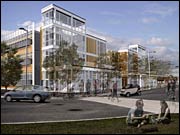
Columbia
Center for Interactive Research on Sustainability, Vancouver, B.C., Canada
Currently under construction, this ambitious project is already earning pre-kudos for being the greenest building in the world. Scheduled to open in 2008, it will feature 100 percent day-lit workspaces, greenhouse-gas neutrality, and on-site treatment of solid and liquid wastes, and it will serve as a state-of-the-art “living laboratory” where sustainable building systems can be researched and assessed in action.
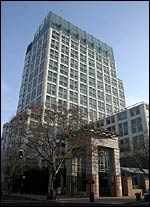
California Environmental Protection Agency Headquarters, Sacramento, Calif., U.S.
It seems only fitting that the leading green agency of the greenest U.S. state would boast the “greenest high-rise in the nation,” as California Gov. Arnold Schwarzenegger describes the California EPA’s 25-story Joe Serna Jr. Building. Completed in 2001, its eco-aspects range from recycled-content ceiling tiles to under-desk worm-composting bins — and the savings from its green features amount to a cool $1 million a year.
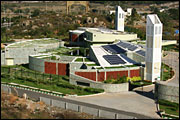
CII-Sohrabji Godrej Green Business Center, Hyderabad, India
The headquarters of the Indian Green Building Council, inaugurated in 2004, was the first building outside the U.S. to earn a LEED platinum rating. It collects rainwater, relies on natural lighting, makes use of solar power, and consumes 55 percent less energy than a conventional structure.

of Natural Resources
Lewis and Clark State Office Building, Jefferson City, Mo., U.S.
The Missouri Department of Natural Resources takes great pride in its award-winning green edifice. Nearly 75 percent of the materials used to build it came from within a 500-mile radius, and 50 percent of the construction waste was recycled. The facility collects rainwater and uses it in toilets, and solar photovoltaic cells on the roof provide a portion of its power needs. “This building … was designed and built to serve the people of Missouri,” says Lt. Gov. Peter Kinder. “In other words, it’s not a show pony; it’s a workhorse — an incredibly efficient workhorse.”

Swiss Re Tower, London, U.K.
Europe’s first green skyscraper features 40 stories of fabulous, pickle-shaped fun. Fondly known as “the Gherkin” (and, one might assume, a few less-publishable nicknames), the aerodynamic headquarters of reinsurance company Swiss Re uses 50 percent less energy than a traditional office building and features gardens on every sixth floor for air purification.

Foundation
Philip Merrill Environmental Center, Annapolis, Md., U.S.
The Chesapeake Bay Foundation may struggle with cleaning up that venerable body of water, but it’s achieved smooth sailing in the green-construction department. Made of eco-materials including sustainably harvested wood and steel recycled from cars and guns, the foundation’s Merrill Center sits on concrete piers to allow parking underneath and is cooled by bay breezes.
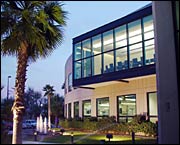
Centro Internacional de Negocios, Ciudad Juarez, Chihuahua, Mexico
The first LEED-certified project in Mexico [PDF] sourced half of its construction materials locally and kept 95 percent of construction waste out of the landfill. A web-based monitoring system lets building managers calculate and compare energy usage, and — in a nod to employee health and air quality alike — the place offers plenty of bike storage, as well as parking privileges for carpoolers.

Almaden Tower and East & West Towers, San Jose, Calif., U.S.
Adobe Systems owns this LEED platinum-certified complex, which accommodates 2,300 employees and one outdoor bocce court. Over the course of five years, the company put $650,000 into eco-features — like an irrigation system that self-adjusts according to weather conditions — and saw $728,000 in savings as a result.
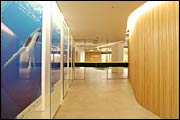
Conservation House, Wellington, New Zealand
Located in a former movie theater complex, this model of sustainability, home of the New Zealand Department of Conservation, opened in February to great acclaim. With eco-innovations including soundproof panels made from milk-bottle tops and a rooftop tearoom set in a garden of native plants, the agency is, says Conservation Minister Chris Carter, “practicing what they preach.”
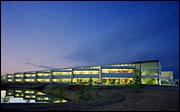
Alberici Corporate Headquarters, St. Louis, Mo., U.S.
This global construction company put its money where its business is in 2004, turning a metal-fabrication building into a shiny new headquarters. With a wind turbine generating 20 percent of the facility’s energy and rainwater catchment saving 500,000 gallons of water a year, the project earned one of the highest ratings ever doled out by the U.S. Green Building Council.
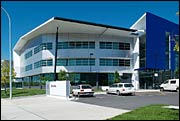
Airport
8 Brindabella Circuit, Canberra International Airport, Canberra, Australia
Putting aside the slight problem that emission-spewing planes fly in and out all day, the Canberra Airport deserves props for constructing an office building that earned the first-ever 5 Green Star rating from the Green Building Council of Australia. Made with 90 percent recycled steel and 100 percent recycled or sustainable timber, the building will get 70 percent of its energy from solar power and use far less water than a typical facility.
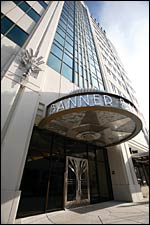
Banner Bank Building, Boise, Idaho, U.S.
The subject of a new documentary, this 11-story, Art Deco-style office building was inspired in part by the landmark book Natural Capitalism. With technical innovations like biodiesel-fueled backup generators and a geothermal heating system, the project “stands at the head of the class and [is] worth studying by others,” says one architect.

Shiodome Tower, Tokyo, Japan
Part office building, part upscale hotel, this addition to Tokyo’s booming Shiodome business district is described as “a sustainable tower that is friendly to people and environment” [PDF]. Domestic clay was used as raw material for the terra cotta tiles on the building’s exterior, and each two-story office unit features a central atrium.
Pacific Controls Headquarters, Dubai, United Arab Emirates
As part of an effort to raise environmental awareness, engineering company Pacific Controls created a five-story “Center of Excellence” for research and development on energy and efficiency solutions. It’s not only the first green building in Dubai, but the first LEED platinum-rated building in the entire Middle East.
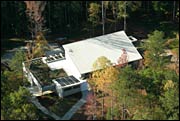
Natural Resources
Sweetwater Creek State Park Visitor Center, Lithia Springs, Ga., U.S.
Proof that building green isn’t just for urbanites comes in the form of Georgia’s Sweetwater Creek State Park Visitor Center, where the pavement is pervious and features like composting toilets and waterless urinals have reduced water use 77 percent. The center is, in the words of one architect, “a great example of how a new way of looking at design is good for the building’s owner, good for the people who use the building on a daily basis, and good for the environment.”
Runners-Up
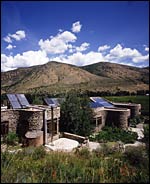
Rocky Mountain Institute Headquarters, Snowmass, Colo.
Not only does green thinking go on inside the office of the energy-efficiency gurus at the Rocky Mountain Institute, but green thinking also drove the design of their Snowmass HQ. The think tank’s legendary building was constructed in 1984 and has been continuously updated since as a showcase for efficient technologies. Even though it’s situated high up in the snowy Rocky Mountains, the building is heated entirely by passive solar using high-tech glazed windows. RMI also has an office in Boulder, Colo., that recently earned the first LEED platinum rating for a commercial interior space.
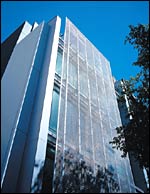
40 Albert Road, Melbourne, Australia
This high rise in South Melbourne earned a six-star rating [PDF] from the Australian Green Building Council. Eighty percent of the waste from its construction was reused or recycled. The building also operates on 70 percent less energy than a conventional structure, and clean onsite power sources, including a fuel cell, are capable of providing more than 30 percent of its energy.
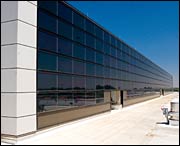
California Department of Education Building, Sacramento, Calif.
The first state-owned office building in the U.S. to earn LEED platinum certification, the retrofitted California Department of Education Building has saved $200,000 a year in energy costs. Greening the edifice and others like it helps the state comply with an executive order from Gov. Arnold Schwarzenegger (R) that calls for a 20 percent reduction in energy use at all state-owned buildings by 2015.
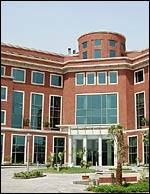
ITC Green Center, Gurgaon, India
ITC, a corporation that specializes in luxury hotels and resorts, went all out to earn LEED platinum certification for its Green Center [PDF] in Gurgaon, outside New Delhi. Forty percent of construction materials came from within 500 miles of the site, 10 percent were reused from other buildings, and all the new wood was certified by the Forest Stewardship Council. The building is energy efficient, the native-plant landscaping is irrigated with recycled water, and exterior lighting is limited to reduce light pollution and provide minimal distraction to nocturnal birds.
Kate Sheppard and Katharine Wroth contributed to this list.


